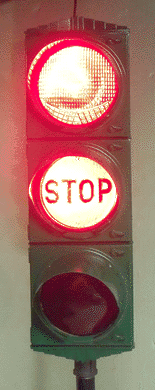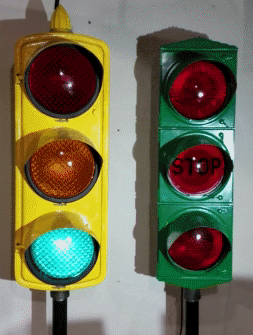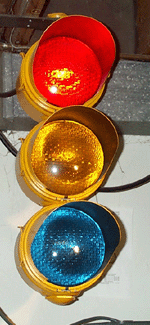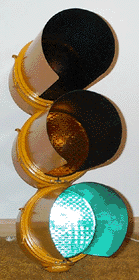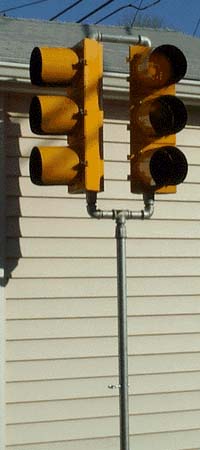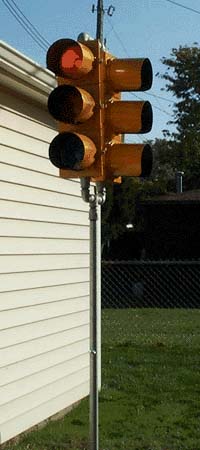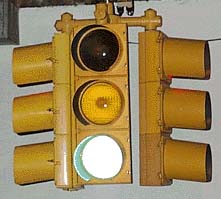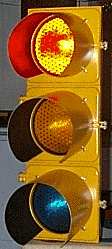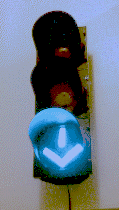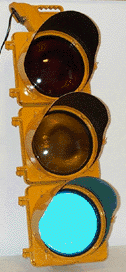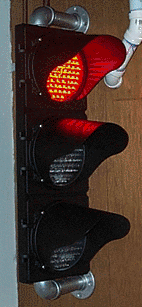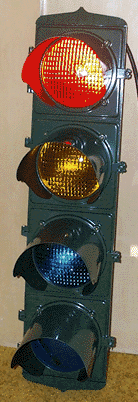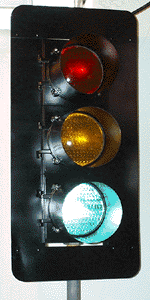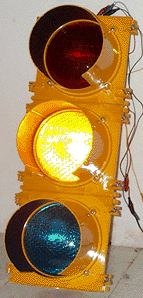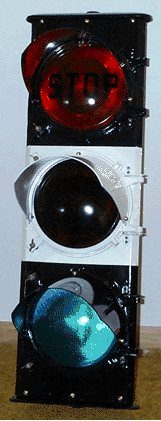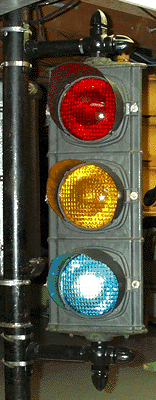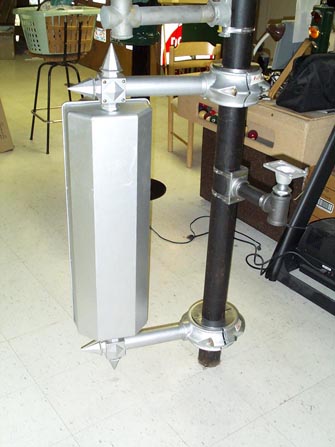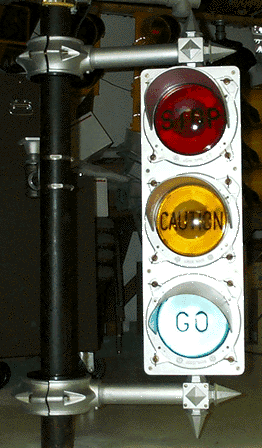This page features 8 inch single face signals.
Some of the pictures below are animated gifs and may take some time to load completely. Some pictures will load a static (non-animated) picture that can be animated by placing your mouse over the picture.
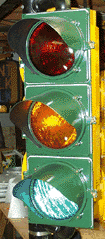 |
G.E. 8 inch groove back signal. This signal has the same basic casting as Econolite 8 inch signals from the 50's and 60's because Econolite took over G.E. in the 1950's and used the same molds but changed the back of the signal slightly.
This signal came with "brick" pattern lenses which are also the same as
Econolite glass lenses except for the G.E. logo in the glass. This signal
sports glass reflectors and has Spider Web lenses in the picture. |
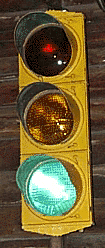 |
Crouse Hinds Art Deco Style Signal with 8 inch Smiley lenses and glass
reflectors. |
|
Here is the first signal set up that I have put outdoors. This 2 way cluster is made of identical Econolite groove back 8 inch signals. The visors on these signals are interesting to me because they go out from the face of the signal at almost a 90 degree angle, unlike Eagle and Crouse Hinds tunnel visors which have a definite slope down when compared to these Econolite visors. This 2 way set up is controlled by a home made 2 phase controller inside the garage. Seven conductor cable that is rated for direct burial runs from the garage, into the ground and up into the signal pole. Put your mouse over either picture to animate the signals. Click on either picture for more about this set up. |
| Here are two very old signals made by Eagle. These signals are held together with 2 rods that run from top to bottom and have end plates. This model is known as the Eaglelux. The end plates on the top and bottom have a rounded "decoration" similar to the Crouse Hinds Art Deco end plates, so I like to call these signals Eagle Art Decos. Some early signals of this model did not have any logo cast in the body on the back as newer models did. Instead, there is a small ID tag riveted to the top or bottom plate on the signal. The signals have glass lenses with the STOP GO flag logo embossed in the center (with the exception of the WALK lens) and they also have glass reflectors. The picture on the left of the green signal with the WALK lens is a static picture. Put your mouse over it to animate it. | 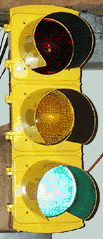 |
| This three way cluster of 8 inch signal heads is typical of the way many signals are set up in Michigan. The side heads are Eagles, made of cast aluminum. The left head is an older type with two rods on the inside that hold the sections together with end plates on the top and bottom. The front head is a Durasig polycarbonate head. Put your mouse over the picture to animate it. Click here to see more pics of this and other Durasig heads. Click here to see more pics of these and other Eagle heads. |
| Singer Aluminum four section 8 inch signal. It really did sequence as shown here when I had it hooked up to my EF-15 controller. Click on the picture to see more pictures of this signal. | Eagle Alusig 8 inch 5 "inline" signal head made of cast aluminum. All glass lenses. The body of this signal is identical to the polycarbonate Durasig head in the front of the three way cluster, but made of Aluminum, not Polycarbonate.
Hold your mouse over the picture to animate the signal. Click on the picture to see more pictures of this signal. |
|
Traffic Signals Inc. made this unique signal. It came with ordinary Kopp Glass lenses so I put in a set of Mac Beth Evans lenses. The signal uses DZUS fasteners to keep the doors closed. The back of this signal is unlike any other signal I have seen. To see some pics of the back, click on the picture. | This Marbelite signal had its reflectors, light bulbs and lenses replaced with LED modules. LED's are supposed to last longer and use less energy than traditional bulbs. There are different types of LED modules. You can actually see the LED's which appear as the bright dots in these modules made by Diallight. Some LED's have a screened look like traditional lenses. To see a front view, move your mouse over the picture. Click on the picture to see the inside of the signal. |
|
|
Here is a sharp looking signal. This one was made by Marbelite. It has Marbelite long bolt lenses in the RYG positions and a Kopp Glass arrow. It also has glass reflectors and the Marbelite exclusive visors that look like a combination tunnel and cutaway visor. But what really makes this signal stand out though is the end plates that resemble Crouse Hinds Art Deco end plates. Hence I call this signal a Marb Deco. What is strange though is that the Eagle and Crouse Hinds signals that used these type of end plates had signal sections that were open on each end and required the end plates to close the ends of the signal. The Marbelite version used closed sections, so the end plates are not necessary. Marbelite must have decided just to include the end plates to add some style to their signals. Also, there are two versions of the Marbelite end plates. One has three vertical stripes on the face of the plate and one that has five vertical stripes. The signal shown is of the five stripe variety. |
| Here is a very rare signal.
It is an ornamental Eaglelux made by Eagle. This signal has a solid cast
body instead of a sectional body. The body of the signal is one piece
cast with provisions for 3 doors/lenses/reflectors. The visors are cast
into the door as one piece also, so the main aluminum parts of this
signal are made up of just 7 pieces. The body, the 3 doors and the 3
reflector frames. The mounting hardware that is used here is
representative of what was used on these signals when they were new in
the early 1930's. The actual finials I used are reproductions. The ball
crosses that the finials are screwed into have tapered threads, not
straight threads. Actual signal hardware has straight threads. The
sequence shown in the animation is what some signals did before national
standards were developed. When going from green to red, the yellow light
would come on with the green for 3-5 seconds, then both would go off and
the red would come on. In the animation, there is a slight dark period
between the green/yellow and red change and between the red and green
change. This was done to mimic old electromechanical controllers that
sometimes were a bit sloppy when changing indications. The actual
controller that I have running this light, the CH
PCN 100, does have this brief dark period between indications which
adds to the classic look of this signal. To see a side view of the
signal, put your mouse over the animation. To see more about this signal,
click here.
|
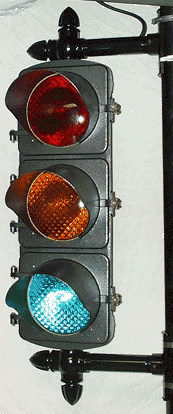
|
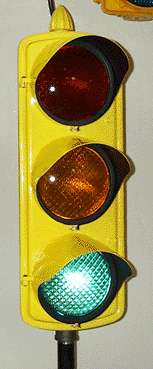 |
Here is another solid body signal. At one time it was believed to have been made by GE because of the reflectors it uses were also used in GE signals. It is now thought to be a "home brew" signal made for the city of Milwaukee, Wisconsin. It is unique in that it only has one door. All three lenses are mounted in the one door. It is known as a Milwaukee signal. I found this signal in incomplete condition. It had an incorrect red lens, a correct Kopp 27 yellow lens, and no green lens. It also was missing all it's insides, the reflectors, sockets, wiring and related hardware. The visors were also missing. The visors on the signal now are reproductions. I was able to find all the original insides for the signal though. This signal is hooked up to the same controller as the ornamental Eaglelux above and has the same green and yellow together indication as was used in some places when this signal was made in the 1930's. |
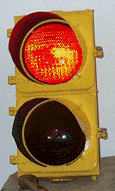 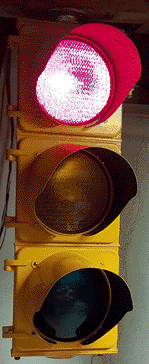
|
This is a rodded Eagle Signal. older type with two rods on the inside that hold the sections together with end plates on the top and bottom. If you have explored some of the more hidden pages on this site, you probably know that I drove semi truck cross country for a while in 2004 and 2005. When I was in Texas, I noticed that they used 2 section wig wag caution and stop beacons at intersections that didn't require a 3 section red yellow green signal. I decided that I wanted to add a signal of this type to this collection so here it is. Update: I decided to turn this wig wag signal into a RYG so I got another complete section and added it. The result is on the right of the wig wag signal. |
| Here is another signal made by G.E. It is a Novalux. This signal is correct with the spider web lenses in it. The G.E. Grooveback pictured at the top of this page has the same lenses in its picture, but is correct with G.E. brick lenses. This Novalux signal is a solid body signal, meaning the body is cast as one piece, not in sections. | 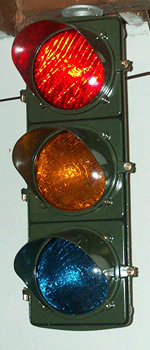
|
Finally, this signal is a Crouse Hinds art deco (DT) drawbridge signal.
